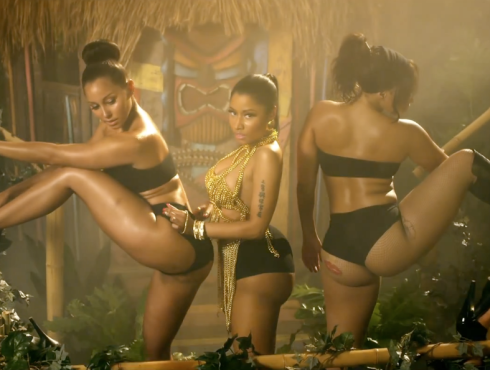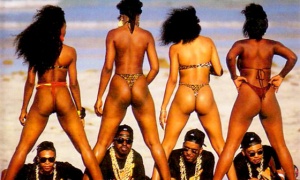Music videos are a popular form of entertainment in our day. But the content of some of these videos may cause us to question our morals and the value of women.
I was recently inspired to get off my ass and dance when I saw the video for Kiesza’s “Hideaway.” This woman and her brigade of dancers perform a perfectly choreographed, seemingly interactive dance down an entire New York street. It was one of those videos that basically inspired me to get up and dance – something I hadn’t truly worked at for a while. But I wanted so badly to embody the energy and art of this music video, it was THAT good. Why hadn’t a music video moved me this much? Why haven’t I felt so impressed by a video in a while? I realized that perhaps it’s because I – along with the rest of society – am being blinded by the booty.
 Image from Nicki Minaj’s scandalous “Anaconda” video, released August 2014.
Image from Nicki Minaj’s scandalous “Anaconda” video, released August 2014.
In Nicki’s image
Rap/pop artist Nicki Minaj has been known for her wide hips and bootylicious features just as much as she’s known for her musical talents. She comes from Trinidad originally, and from a music industry standpoint, she truly climbed her way up a ladder. She released three mixtapes that got her in the public’s eye before signing with rap music monster Young Money Entertainment. I remember watching a VH1 documentary about her that showed a real nitty-gritty gal who was about her work. Yet whenever I hear about Nicki in the media or from a peer nowadays, it’s through a sexual scope. In most eyes, Nicki is an attractive and shapely woman, but, why is her work ethic not as big a topic as her rear-end?
In August of this year Nicki released a controversial video for a song she called “Anaconda”, a remix of Sir Mix-a-Lot’s “Baby Got Back.” Both songs are sexual in nature, so it was expected for Nicki’s visuals to contain imagery of women’s bodies – but was ALL of that really necessary? Maybe. It racked up nearly 150 million views on YouTube within one month. There’s hardly a shot where some sort of cheeks aren’t bouncing about the screen. It’s become a staple that we’re used to when seeing American rap videos – naked women with accentuated features, and usually items of monetary significance.
When did it change?
It seems today’s music consumers have become less interested in the content of the art and more inclined to know how good a celebrity can look, or particularly for female artists, how well they can work a pole.
But is that true? When you talk to a lot of music fans, they won’t deny enjoying a beautiful woman dancing on their screen, but they often agree that music has lost its substance. So why then does our culture keep perpetuating these type of shallow values and means of success? It’s not necessarily a new thing. After all, booties have been a big deal since the days of Uncle Luke and 2LiveCrew.
Some believe we live in a more often than not misogynist society, and that women’s place and value can be altered or determined by something as trivial as physical appearance. A study conducted by MU professors in 2012 found that the concept of sexual objectification of females occurred equally throughout the realm of music videos, regardless of the female’s race. They also point out that while men in videos do objectify women often, many female artists were objectifying themselves. So, is it a pressure from society to keep showing that you’re sexy? Or do women simply just care about being hot now?
Return to our roots
Let me answer the question above: it’s both.
I don’t want to say women are giving into the power of misogyny, but videos like Nicki’s sure make it seem so. I personally have to give Minaj props for playing the other side of that coin – she doesn’t allow the public or fellow artists to make her feel ashamed for displaying a bold, brash, and out-there personality. That’s who she is as an artist, and at least she remains true to that.
But I want to see my fellow women work harder. I want to see ladies laying down choreography like Kiesza, or the women of TLC. Both videos are proof that a female artist can dress sexy while not inappropriate, and engage in something that truly requires skill and discipline. If women in the public eye continue to feed a cycle of belittling and sexual demise, it won’t stop. Too many women have become complacent with men telling them how the world should be; I want – no, need – more women to be brave in their endeavors. What you do now influences who comes after you, and especially in the music world, you never know who has their eye on you.
